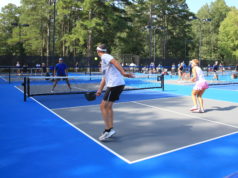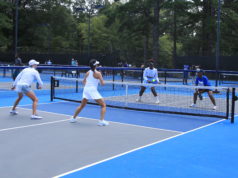By Kim Freeman, Junior Leagues Vice President
For junior tennis players, consistent practice is essential to improving their skills and developing a love for the game. While tennis lessons with a coach provide invaluable instruction, practicing independently can significantly boost a player’s performance. This article discusses effective ways for young tennis players to practice on their own between lessons.
The importance of solo practice
Practicing alone allows juniors to take ownership of their development. It fosters independence, helps reinforce what they have learned in lessons, and encourages self-discipline. Solo practice can also be tailored to a player’s specific needs, allowing them to focus on areas where they want to improve.
Wall drills – How to do it: Find a tennis wall or a sturdy backboard. Players can practice their forehand and backhand shots by hitting the ball against the wall and varying their angles and spins. Another wall drill is to softly bump the wall with the right and left hands. Benefits: Wall drills help improve accuracy, consistency, and stroke technique.
Shadow swings – How to do it: Without a ball, practice the full motion of different strokes — forehands, backhands, volleys, and serves — focusing on form and footwork. Benefits: Shadow swings enhance muscle memory and technique without the distractions of ball contact.
Holding the tennis racquet in the continental grip at home or even in the car – Benefits: This helps with muscle memory on the proper way to hold your racquet.
Serving practice – How to do it: Use a stationary target (like cones) on the other side of the court to aim at while serving. Explore different types of serves (flat, slice, kick) to develop versatility. Throwing a small football with a spiral can also help improve serving. Benefits: Focusing on serve precision and technique can lead to higher serve percentages during matches.
Conditioning and fitness – How to do it: Incorporate running, jumping rope, and strength exercises into a practice routine to build fitness and stamina. Benefits: Cardiovascular fitness and muscle strength greatly enhance on-court performance.
Setting goals
Young players should set achievable, specific goals for their solo practices. Whether it is perfecting a particular stroke, increasing serve speed, or improving footwork, having clear objectives will motivate them and give structure to their practice sessions.
Keeping it fun
To maintain enthusiasm, juniors can incorporate games or challenges during their solo practice. For instance, they can set a target number of forehands in a row or create a fun scoring system for wall drills. Making practice enjoyable is key to fostering a lifelong love for tennis.
While lessons with a coach provide essential guidance, solo practice is a vital component of a junior tennis player’s development. By dedicating time to practice independently, young players can refine their skills, enhance their understanding of the game, and gain confidence that will translate into success on the court. Encouraging this independence not only improves their tennis ability but also cultivates a strong work ethic and self-discipline that will benefit them beyond the game.
The cumulative effect of the above tips will not only improve technical skills, but also physical skills and mental toughness.




